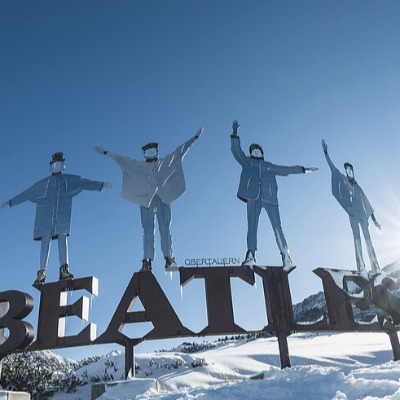Austrian Alpine Club Reports Record Glacier Melt

The annual glacier report of the Austrian Alpine Club provides comprehensive information about the development of the local glaciers.
Never before in the history of the Alpine Club's glacier measurement service, which dates back to 1891, has there been a greater loss of glaciers: on average, the 89 Austrian glaciers observed by the Alpine Club have become 28.7 meters shorter. This enormous increase in the mean retreat compared to the previous year (11 meters) means red alert (!): The glacier retreat is continuing at a rapid pace. The largest change in length was again measured by the voluntary Alpine Club glacier measurers in the Venice Group, where the Schlatenkees (Tyrol) retreated by 89.5 meters (previous year: 54.5 meters) in length. The Pasterze (Carinthia) lost a volume of 14.7 million m³ of ice in the area of the glacier tongue alone, which corresponds to a cube with an edge length of 245 m, i.e. approximately the height of the Danube Tower in Vienna.
The glacier budget year 2021/22 was extremely unfavorable to glaciers. All 89 glaciers observed by the Alpine Association's volunteer glacier surveyors retreated and also lost, mostly significantly, in area and volume. The mean retreat amount of the 78 glaciers measured in both 2021 and 2022 was -28.7 m, which is not only 2.6 times larger than the value of the previous year (-11.0 m, calculated for 79 glaciers), but also by 3.5 m larger than the previous maximum value (-25.2 m) from the measurement year 2016/17. Since the start of glacier measurements by the Austrian Alpine Association, there have only been five years with average retreat values of more than 20 meters - and all since 2006.
Schlatenkees (Tyrol), which is in decline, had the highest retreat value in Austria at -89.5 meters. The Pasterze (Carinthia) has retreated by 87.4 meters in length. The third highest value, namely - 84.3m, was measured by the Alpine Club's knives on the Diemferner (Tyrol). "This result can be explained by the combination of below-average amounts of snow in winter and another long and very warm melting period, which began at the turn of May/June and lasted into September," analyze Gerhard Lieb and Andreas Kellerer-Pirklbauer, heads of the Alpine Club glacier measurement service and full-time at the Institute for Geography and Spatial Research at the University of Graz.
By the second half of July 2022 at the latest, most glaciers were ice-free for well over half of their area. At the time of the maximum snowfall in September, all glaciers only had narrow strips of firn or snow in the highest parts of the glacier. As a result, no glacier still had a significant feeding area, but the Austrian glaciers had almost completely become feeding areas and lost massive amounts of ice even in the highest areas. The arrival of Saharan dust in mid-March through currents from the south was also important for the summer melting process on the glaciers: This remained stored in the snow cover in the high mountains and darkened the snow cover after the snow layers above it had melted in summer.
"In terms of weather and snow, the fiscal year is one of the most unfavorable in the history of glacier research - even in a period in which every year is unfavorable to glaciers," according to the analysis by the heads of the Alpine Association's measurement service, Lieb and Kellerer-Pirklbauer. "This year's by far highest retreat value since the beginning of the Alpine Association's measurement series 132 years ago undoubtedly makes the consequences of the anthropogenic massively intensified climate change clear: The drastic glacier retreat that is currently and will probably continue to prevail in the future will make the Austrian Alps as good as ice-free in the long term - "optimistic" this will be in 2075, but probably much earlier. The glaciers are still feeding on the ice reserves of the past and would have disappeared if the current climate conditions had not only started around 1990,
Alpine Club demands protection of high alpine regions
The Austrian Alpine Association as a nature conservation organization has been committed to the protection of glaciers and the surrounding high alpine regions for years without exception. In a press conference on March 23, 2023, he again spoke out vehemently against the further expansion of glacier ski areas. Together with the friends of nature, the WWF and the German Alpine Association, the Austrian Alpine Association is requesting the Tyrolean state government to reject the ski-technical expansion plans on the three glaciers around the Linke Fernerkogel in the Pitztal and instead to expand the quiet area of the Ötztal Alps. From the point of view of the Alpine Club, the touristic development of glacier areas is simply no longer justifiable at a time when the climate crisis is already having an enormous impact on the glaciers.
In this context, it is particularly important for the Austrian Alpine Club to provide ongoing information to members with a call to take action against the progression of the climate crisis: "We have to keep in mind the unpleasant consequences for people," warns Ingrid Hayek, Vice President of the Austrian Alpine Club. “The rapid global melting of glaciers is a major contributor to sea level rise, including floods and mudslides. The lack of natural water reservoirs in the mountains subsequently leads to regional drought,” says Hayek.
Difficult terrain conditions
The glaciers are retreating and in many areas it is now the case that accessibility is no longer given: the terrain conditions become more difficult as the glaciers retreat. Then, in most areas, very steep, loose scree remains or the higher parts of the terrain are only accessible via very difficult rock sections.
“When that's the case, glacier measurements stop because it just becomes too dangerous to do. There are then two scenarios: Either the glacier in question continues to be observed through photo comparisons in order to see whether it has increased or decreased. Or it will be taken out of the range,” explain Lieb and Kellerer-Pirklbauer. And of course that happens again and again - in 2022 this was the case with the Bieltalferner in the Silvretta group. Due to the increasingly difficult conditions, the total number of glaciers measured is tending to decrease.
Glacier measurement service in figures
The glacier measuring service of the Austrian Alpine Club has been observing the local glaciers for 132 years and meticulously registering their length changes. Measurements of flow velocities and surface elevation changes are also carried out on some glaciers. Those responsible for the area – all volunteer glacier surveyors from the Austrian Alpine Club – took a close look at 89 glaciers in twelve mountain groups across Austria – from the Dachstein to the Silvretta. The glacier reports and the photo documentation from the Alpine Club archives convey a unique picture of the development of the glaciers in the Eastern Alps and are scientifically of international relevance.
Comprehensive glacier report & information
All results and detailed analyzes of the current analysis of the local glaciers can be read in the Alpine Club magazine Bergauf #2.2023 (www.alpenverein.at/bergauf). The collected glacier reports of the past years and further information on the glacier measuring service can be found at www.alpenverein.at/gletscher.













